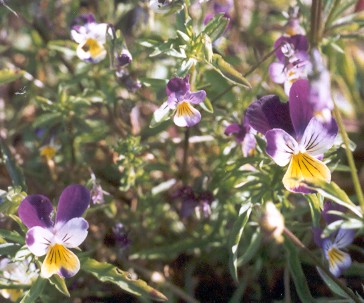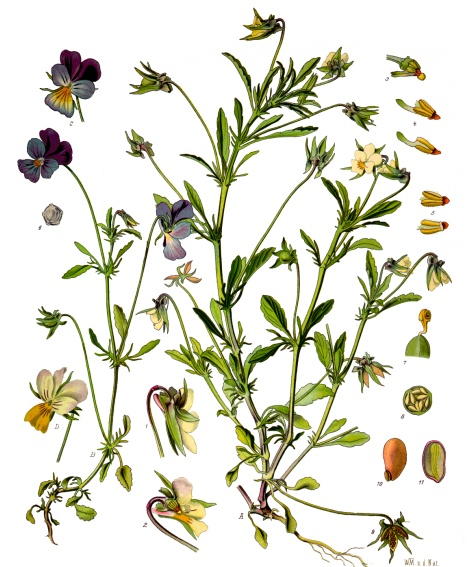
Viola tricolor (L)
Synonyms and Common names: Wild pansy, love-lies-bleeding, love in idleness, live in idleness, Herb Constancy, bullweed, bird�s eye, herb trinity , Johnny jumper, stepmother
German = Dreifarbiges veilchen, Spanish = Pensamiento, Italian = Pensiero, French = Pensee
Order: Violaceae

Description: an annual or perennial herb common on disturbed, sandy soils in Britain and Western Europe and which grows up to 40 cm in height. It has a semi-creeping or ascending stem, usually richly branched, growing from a spindle-shaped simple root. The alternate, stalked leaves have large stipules, deeply lobed and with an oval terminating section. The lower leaves are almost round, the upper ones oval and coarsely to sparsely toothed at the edges. The bisexual symmetrical flowers, 1-2.5cm across, grow individually from the leaf axils on long stalks which bend into a hook at the top with a small stipule. The five tapering and pointed sepals have a round or oval appendix at the base. The corolla is light yellow and the upper petal and spur usually purplish. The five stamens have short filaments. The superior ovary matures into an oval capsule with light brown seeds.
Parts used: aerial parts
Collection: The herb should be harvested during the growing season from March to August.
Constituents: Flavonoids (including violanthin, rutin), salicylic acid
and salicylates, saponins, unidentified alkaloid, tannins, mucilage, gums, resin
saponins, unidentified alkaloid, tannins, mucilage, gums, resin
Actions: expectorant, diuretic, anti-inflammatory, antirheumatic, laxative
Indications: Pertussis, acute bronchitis, cystitis, polyuria and dysuria, capillary fragility. cutaneous affections. Specifically indicated in eczema and skin eruptions with serous exudate, particularly when associated with rheumatic symptoms.
Therapeutics and Pharmacology: Viola tricolor can be used both internally and as a compress or ointment in the treatment of eczema, psoriasis and acne and it is a suitable remedy for clearing cradlecap in babies. It is also to treat gout and rheumatoid arthritis, where the salicylates and rutin exert an anti-inflammatory action. It can be used to treat a variety of respiratory disorders such as catarrhal bronchitis. The saponins account for its mild expectorant action and the mucilage is soothing to the respiratory tract. The herb is also diuretic and can be used as part of a treatment for polyuria and dysuria. It is reputed to be of benefit in nocturnal enuresis in children.
The flowers contain a high concentration of rutin which helps prevent bruising and heals broken capillaries. It also reduces fluid build-up in the tissues and helps prevent atherosclerosis, thereby lowering blood pressure.
Combinations: Viola tricolor can be combined with Tussilago and /or Urginea in whooping cough. It may be used with Rumex, Galium, Trifolium and Urtica in eczema, and can be combined with Agropyron, Eupatorium purpureum and Barosma in cystitis.
Preparation and Dosage: (thrice daily)
Regulatory Status: GSL Schedule 1
Dried herb: Dose 2-4 g or by infusion
Liquid Extract: 1:1 in 25% alcohol, 2-4 ml
Additional Comments: An infusion of the plant was said to help mend a broken heart, hence its common name Heartsease.
Bibliography
Bartram, T. 1995 Encyclopedia of Herbal Medicine, 1st edn., Grace Publishers, Bournemouth.
BHMA 1983 British Herbal Pharmacopoeia, BHMA, Bournemouth.
Bremness, L. 1994 Herbs, Dorling Kindersley Eyewitness Handbook, London.
Chevallier, A. 1996 The Encyclopedia of Medicinal Plants, Dorling Kindersley, London.
Grieve, M. 1931 A Modern Herbal, (ed. C.F. Leyel 1985), London.
Hoffmann, D. 1990 The New Holistic Herbal, Second Edition, Element, Shaftesbury.
Lust, J. 1990 The Herb Book, Bantam, London.
Mabey, R. (ed.) 1991 The Complete New Herbal, Penguin, London.
Ody, P. 1993 The Herb Society's Complete Medicinal Herbal, Dorling Kindersley, London.
Rogers, S.K. 1995 British and Chinese Herbal Pharmacopoeia, Healthlink Software Systems, Australia
Polunin, M. and Robbins, C. 1992 The Natural Pharmacy, Dorling Kindersley, London.
Prihoda, A. 1989 The Healing Powers of Nature, Octopus, London.
Weiss, R.F. 1991 Herbal Medicine, Beaconsfield Arcanum, Beaconsfield.
Wren, R.C. 1988 Potter's New Cyclopaedia of Botanical Drugs and Preparations, C.W.Daniel, Saffron Walden.










